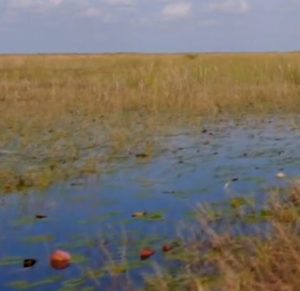(By Kim Ryan) On Thursday evening, the Sanibel Captiva Conservation Foundation presented its annual Everglades Update at the Bailey Homestead Preserve and via zoom. This free, annual event is offered in partnership with The Everglades Foundation and focuses on important Everglades restoration projects, development of the Lake Okeechobee System Operating Manual, and Senate Bill 2508—the most recent attempt by the sugar industry to undermine the LOSOM process.
The program featured Steve Davis, Ph.D., Chief Science Officer for The Everglades Foundation, and Paul Julian, Ph.D., Hydrological Modeler for SCCF and the Conservancy of Southwest Florida.
James Evans, CEO of the SCCF moderated and began the educational evening with a comprehensive and understandable presentation which included a historical map of how water flow through the Everglades area has morphed over the years, and an overview of CERP the Comprehensive Everglades Restoration Plan which is a group of approximately 68 projects/components to restore, protect, and preserve the region’s water resources. Evans discussed the importance of regional partnerships which are critical in the effort to protect the Everglades and the Northern estuaries which includes the Caloosahatchee. He explained how restoring the whole system is not only an important ecological endeavor but also important to the economic viability of our entire area.
Both panelists spoke about moving more water south to the Everglades and into the Florida Bay and how the EAA reservoir ,which has yet to be built, will play a huge role in addressing that need. They also explained how the C-43 (Caloosahatchee River West Basin) reservoir will capture and store stormwater runoff from the basin reducing excess water flow to the estuary, capture and store releases from Lake Okeechobee reducing discharges and improve the salinity balance.
When talking about the new Lake Okeechobee System Operating Manual both agreed it was a more balanced plan than the previous LORS 08. Dr. Julian informed listeners the plan would triple water sent south and create a 37% decrease in harmful releases east and west.
As the presentation turned to SB 2508, which has many conservation groups and other stakeholders up in arms, Dr. Davis said it ties the hands of SFWMD to manage water and puts politics in the driver’s seat instead of ecology. He referred to the amended bill as still having challenging language.
When asked what needs to be done to advance restoration efforts the answer was the political will to increase federal funding to complete the projects. They encouraged those in attendance to stay engaged, advocate, and educate others on the need to restore the Everglades for ecological and economic reasons. The economy of the future is water.

